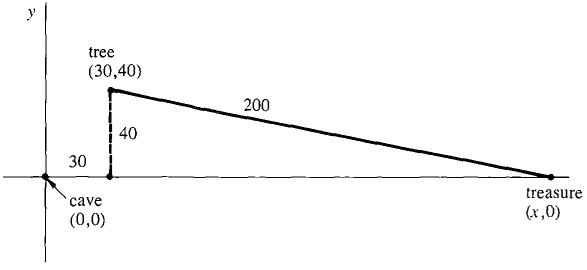| The ebook Elementary Calculus is based on material originally written by H.J. Keisler. For more information please read the copyright pages. |

|

Home  Continuous Functions Continuous Functions  How to Set Up a Problem How to Set Up a Problem  Examples Examples  Example 1: Treasure Map (One Variable) Example 1: Treasure Map (One Variable) |
|||||||






|
|||||||
Example 1: Treasure Map (One Variable)
According to a treasure map, a buried treasure is located due east of a cave and is 200 paces from a tree. The tree is 30 paces east and 40 paces north of the cave. How far is the treasure from the cave? The solution of this problem uses the quadratic formula, which will be needed throughout the calculus course. We review it here. We solve Example 1 in three steps.
Figure 3.1.1
INTERPRET THE SOLUTION Since x ≥ 0, we reject the negative solution. Thus x = 30 + The treasure is approximately 226 paces from the cave. Most calculus problems involve two or more variables.
|
|||||||
Home  Continuous Functions Continuous Functions  How to Set Up a Problem How to Set Up a Problem  Examples Examples  Example 1: Treasure Map (One Variable) Example 1: Treasure Map (One Variable) |
|||||||
Last Update: 2006-11-15



 , x ≥ 0.
, x ≥ 0. 
 ~ 226 paces.
~ 226 paces.